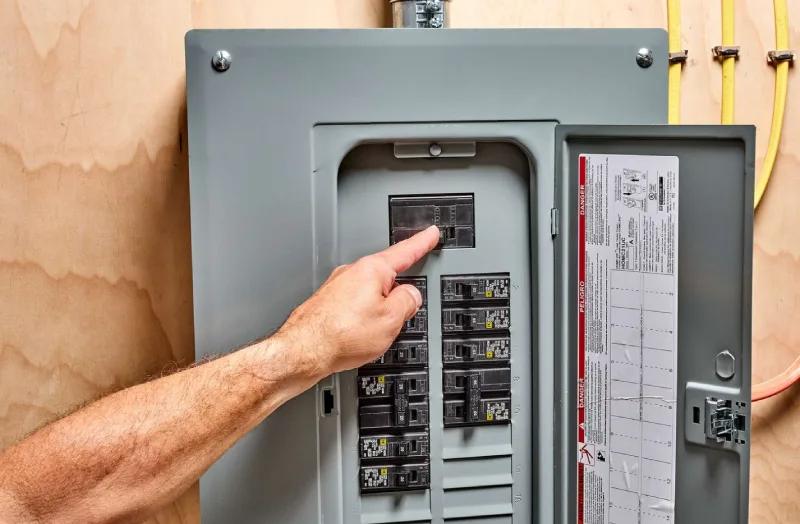What is Electrical Load in Your Home?
Electrical load refers to the total amount of electrical power being consumed by all devices, appliances, and systems in your home at any given time. It’s measured in amperes (amps) and represents the demand placed on your electrical system.
Key Terms You Need to Know:
- Amperage (Amps): The measurement of electrical current flow
- Connected Load: Total potential power consumption of all electrical devices
- Demand Load: Actual power being used at peak times
- Service Capacity: Maximum amperage your electrical panel can safely handle
- Circuit Load: Power consumption on individual circuits
Why Determining Your Home’s Load Matters
Bezpieczeństwo i zgodność z przepisami
- Prevents electrical fires caused by overloaded circuits
- Ensures NEC (Krajowy Kodeks Elektryczny) zgodność for installations
- Protects against dangerous voltage drops that damage appliances
- Maintains insurance coverage through proper electrical maintenance
Planning and Upgrades
- Determines if electrical panel upgrades are needed before major renovations
- Guides appliance purchases to avoid overloading existing systems
- Helps size generators for backup power needs
- Informs solar panel system design for optimal energy production
Complete Methods to Determine Your Home’s Electrical Load
Method 1: Professional Load Calculation (Most Accurate)
Step-by-Step Process:
- Hire a licensed electrician to perform a comprehensive load analysis
- Document all electrical devices including HVAC, water heater, and appliances
- Apply NEC demand factors for different types of loads
- Calculate connected vs. demand load using professional software
- Receive detailed report with upgrade recommendations
Oś czasu: 2-4 hours | Koszt: $200-$500 | Dokładność: 95-99%
Method 2: DIY Load Assessment (Good Estimate)
Wymagane narzędzia:
- Digital multimeter or clamp meter
- Latarka
- Notebook for recording data
- Calculator
Step-by-Step Process:
- Locate your main electrical panel and identify the main breaker rating
- List major appliances with their amperage ratings (found on nameplates)
- Measure individual circuit loads using a clamp meter during peak usage
- Calculate total connected load by adding all amp ratings
- Apply diversity factors (typically 70-80% of connected load for actual demand)
Method 3: Whole-House Energy Monitoring (Real-Time Data)
Recommended Monitors:
- Sense Energy Monitor: Real-time usage tracking
- Emporia Vue: Individual circuit monitoring
- Curb Energy Monitor: Professional-grade system
Proces instalacji:
- Install monitoring clamps around main electrical feeds
- Connect to Wi-Fi network for data transmission
- Monitor usage patterns for 2-4 weeks
- Identify peak demand periods and high-usage appliances
- Calculate average and maximum loads from collected data
Electrical Load Calculation Methods Comparison
| Metoda | Dokładność | Koszt | Time Required | DIY Friendly | Najlepsze dla |
|---|---|---|---|---|---|
| Professional Calculation | 95-99% | $200-$500 | 2-4 godziny | NIE | Major renovations, panel upgrades |
| DIY Assessment | 70-85% | $50-$150 | 4-8 hours | TAK | General planning, basic understanding |
| Monitorowanie energii | 90-95% | $200-$400 | 2-4 weeks | Umiarkowany | Ongoing optimization, solar planning |
| Utility Bill Analysis | 60-75% | Free | 1 godzina | TAK | Quick estimates, basic awareness |
How to Read Your Electrical Panel for Load Information
Identifying Your Service Capacity
Main Breaker Rating indicates maximum capacity:
- 100 Amp Service: Older homes, basic electrical needs
- 150 Amp Service: Medium homes with standard appliances
- 200 Amp Service: Modern homes with electric heating/cooling
- 400 Amp Service: Large homes with extensive electrical systems
Circuit Breaker Analysis
Individual Circuit Loads:
- 15 Amp Circuits: Standard outlets, lighting
- 20 Amp Circuits: Kitchen outlets, bathroom outlets
- 30-50 Amp Circuits: Electric dryers, ranges, water heaters
- 60-100 Amp Circuits: HVAC systems, electric vehicle chargers
🔧 Wskazówka eksperta: Wyłączniki automatyczne are sized at 125% of expected load for safety margin. A 20-amp circuit should carry no more than 16 amps continuously.
Major Appliance Load Requirements Table
| Appliance | Typical Amperage | 240V vs 120V | Load Factor |
|---|---|---|---|
| Zasięg elektryczny | 40-50 amps | 240V | Wysoki |
| Suszarka elektryczna | 24-30 amps | 240V | Średni |
| Podgrzewacz wody | 18-25 amps | 240V | Średni |
| HVAC System | 15-60 amps | 240V | Wysoki |
| Refrigerator | 3-5 amps | 120V | Ciągły |
| Mikrofalowy | 10-12 amps | 120V | Średni |
| Dishwasher | 8-10 amps | 120V | Średni |
| Washing Machine | 5-7 amps | 120V | Średni |
Step-by-Step DIY Load Calculation Process
Phase 1: Data Collection
- Record main panel information:
- Main breaker amperage rating
- Number and size of individual breakers
- Panel manufacturer and model
- Document major appliances:
- Nameplate amperage ratings
- Voltage requirements (120V or 240V)
- Usage patterns (continuous vs. intermittent)
- Identify lighting and outlet loads:
- Count outlets and fixtures per circuit
- Estimate wattage per room
- Note any specialty lighting systems
Phase 2: Load Calculations
Basic Calculation Formula:
Total Connected Load = Sum of all appliance amp ratings Estimated Demand Load = Connected Load × 0.75 (diversity factor)
Przykładowe obliczenia:
- Electric Range: 40 amps
- HVAC System: 30 amps
- Water Heater: 20 amps
- Other Appliances: 25 amps
- Total Connected: 115 amps
- Estimated Demand: 115 × 0.75 = 86 amps
Phase 3: Safety Assessment
Load Safety Guidelines:
- 80% Rule: Never exceed 80% of panel capacity continuously
- Individual Circuits: Maximum 80% of breaker rating
- Future Planning: Reserve 20-30% capacity for additions
⚠️ Critical Safety Warnings
Do Not Attempt These Tasks Without Professional Help:
- Opening electrical panels or removing covers
- Working with main electrical feeds
- Installing monitoring equipment on main breakers
- Any work involving 240V circuits
Signs You Need Professional Assessment:
- Frequent breaker trips or blown fuses
- Przyciemnianie świateł podczas uruchamiania urządzeń
- Warm outlets or electrical panels
- Burning smells near electrical equipment
- Plans for major electrical additions
Common Load Calculation Mistakes to Avoid
Mistake 1: Ignoring Diversity Factors
Problem: Adding up all appliance ratings without considering actual usage
Rozwiązanie: Apply 70-80% diversity factor for realistic demand calculation
Mistake 2: Overlooking Future Needs
Problem: Calculating only current load without planning for additions
Rozwiązanie: Reserve 20-30% capacity for future electrical needs
Mistake 3: Misunderstanding Continuous vs. Non-Continuous Loads
Problem: Treating all loads as intermittent
Rozwiązanie: Apply 125% factor to continuous loads (3+ hours operation)
When to Upgrade Your Electrical Service
Clear Indicators for Panel Upgrades
Capacity Issues:
- Current load exceeds 80% of panel rating
- Planning major electrical additions (EV charger, pool, workshop)
- Installing solar panel systems
- Adding electric heating or cooling systems
Age and Safety Factors:
- Panels over 25 years old
- Federal Pacific or Zinsco panels (safety hazards)
- Fuse boxes instead of circuit breakers
- Insufficient grounding systems
Professional Load Calculation vs. DIY Comparison
| Aspekt | Profesjonalny | DIY |
|---|---|---|
| Dokładność | Uses NEC demand factors and engineering calculations | Basic estimates with standard factors |
| Zgodność Kodu | Ensures all calculations meet local codes | May miss specific code requirements |
| Obciążenie | Professional carries insurance and licensing | Homeowner assumes all responsibility |
| Dokumentacja | Provides certified reports for permits | Informal calculations only |
| Koszt | $200-$500 initial investment | Time investment plus basic tools |
Pytania i odpowiedzi
What’s the difference between connected load and demand load?
Connected load is the total amperage of all electrical devices if they operated simultaneously. Demand load is the actual maximum power consumption based on realistic usage patterns, typically 70-80% of connected load due to diversity factors.
How do I know if my electrical panel can handle additional load?
Calculate your current demand load and compare it to 80% of your panel’s capacity. If adding new load would exceed this threshold, you need a panel upgrade. For example, a 200-amp panel should not exceed 160 amps of continuous load.
Can I determine electrical load from my utility bill?
Yes, but with limited accuracy. Divide your highest monthly kWh usage by 730 hours, then divide by your home’s voltage (typically 240V) to estimate average amperage. This method shows consumption but not peak demand or individual circuit loads.
What appliances use the most electricity in my home?
Highest electrical loads typically include:
- HVAC systems (heating and cooling)
- Podgrzewacze wody elektryczne
- Electric ranges and ovens
- Suszarki elektryczne
- Ładowarki do pojazdów elektrycznych
How often should I reassess my home’s electrical load?
Reassess your electrical load when:
- Adding major appliances or systems
- Planning home renovations or additions
- Installing solar panels or backup generators
- Experiencing frequent electrical issues
- Every 5-10 years as part of electrical maintenance
What’s the minimum electrical service for modern homes?
Most building codes require 200-amp service for new construction. Homes with all-electric systems (heating, cooking, water heating) may need 300-400 amp service, especially with electric vehicle charging capabilities.
Porady ekspertów i kolejne Kroki
Immediate Actions You Can Take
- Locate and photograph your electrical panel with main breaker rating visible
- Create an appliance inventory with nameplate amp ratings
- Monitor your electrical usage for one complete billing cycle
- Schedule professional assessment if planning major electrical work
Kiedy zadzwonić do profesjonalnego elektryka
Obowiązkowa konsultacja zawodowa:
- Service panel upgrades or replacements
- Adding circuits for major appliances
- Installing whole-house surge protection
- Electrical work requiring permits
- Any safety concerns with existing wiring
Cost-Effective Load Management Strategies
Reduce Electrical Demand:
- Install programmable thermostats for HVAC efficiency
- Upgrade to LED lighting throughout the home
- Use smart power strips to eliminate phantom loads
- Schedule high-load appliances during off-peak hours
- Consider energy-efficient appliance replacements
Conclusion: Ensuring Safe and Adequate Electrical Capacity
Understanding your home’s electrical load is fundamental to electrical safety, code compliance, and efficient energy management. While basic load estimates can be calculated by homeowners, professional assessment ensures accuracy and safety for major electrical decisions.
Kluczowe wnioski:
- Never exceed 80% of your electrical panel’s rated capacity
- Professional calculations are required for permits and major upgrades
- Monitorowanie w czasie rzeczywistym provides the most accurate ongoing load data
- Bezpieczeństwo zawsze na pierwszym miejscu – consult licensed electricians for complex assessments
For major electrical work, additions, or safety concerns, always consult with a licensed electrician who can provide certified load calculations and ensure all work meets local electrical codes and safety standards.





